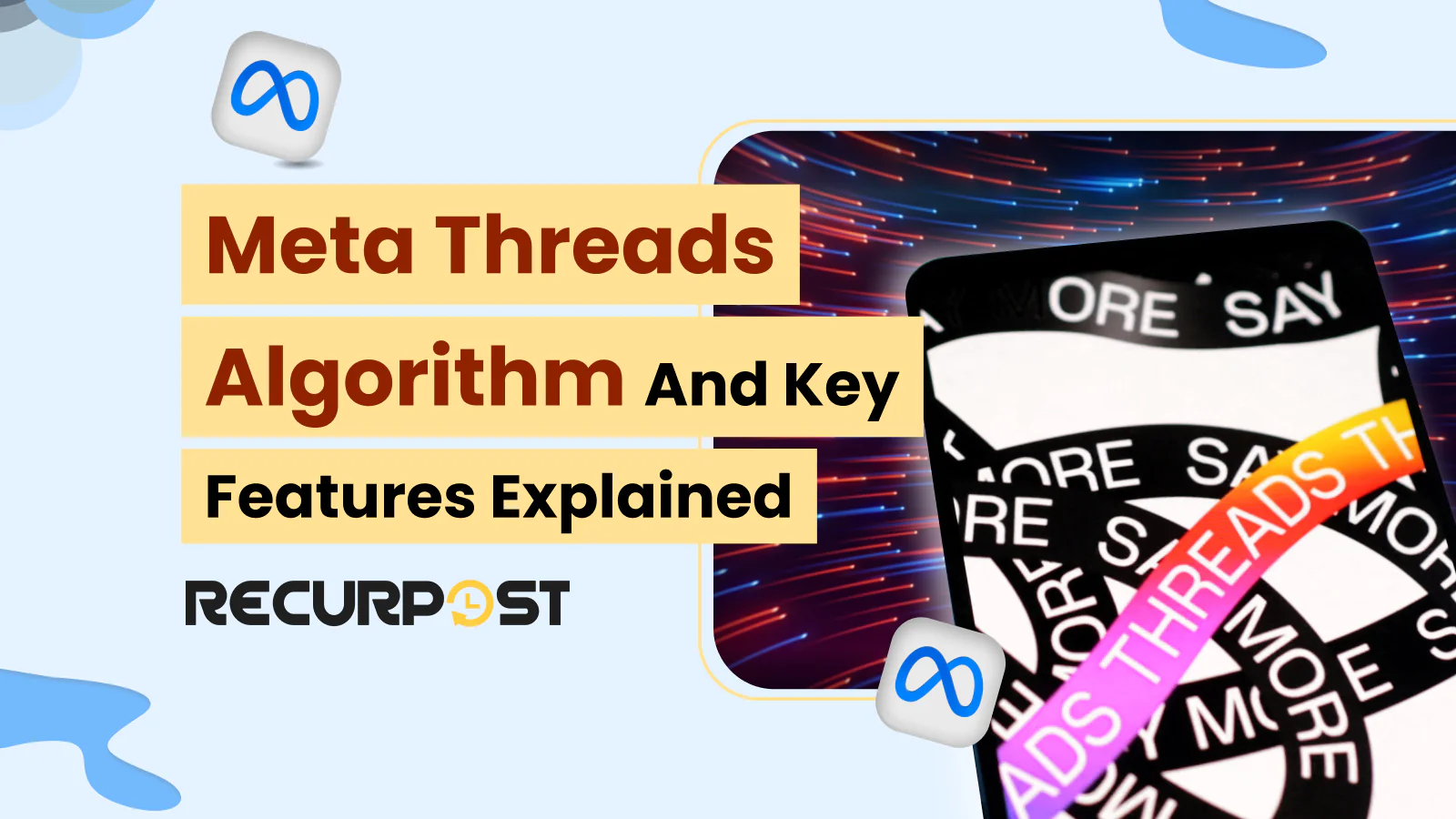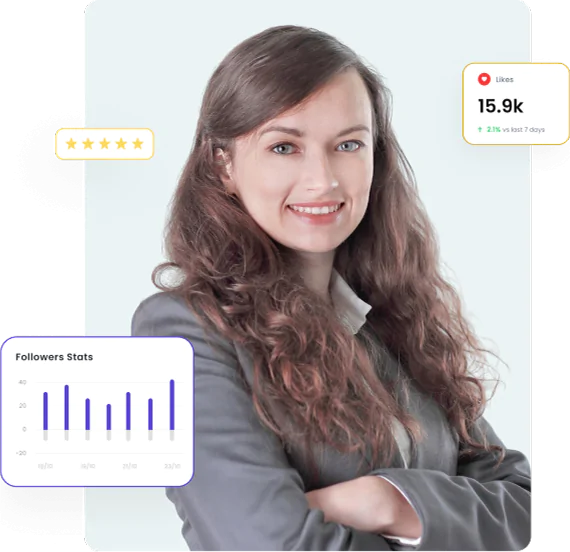Meta Threads algorithm selects posts for your feed based on recency and engagement metrics. Each like, comment, and share increases a post’s reach, while fresh content receives priority distribution.
Meta Threads burst onto the scene in July 2023 as a text-first companion to Instagram. You log in with your Instagram account, keep your handle and followers, then post up to 500 characters of text, links, photos, or short videos.
By mid-2024, it hit 100 million users. By early 2025, it doubled to 200 million monthly active users.
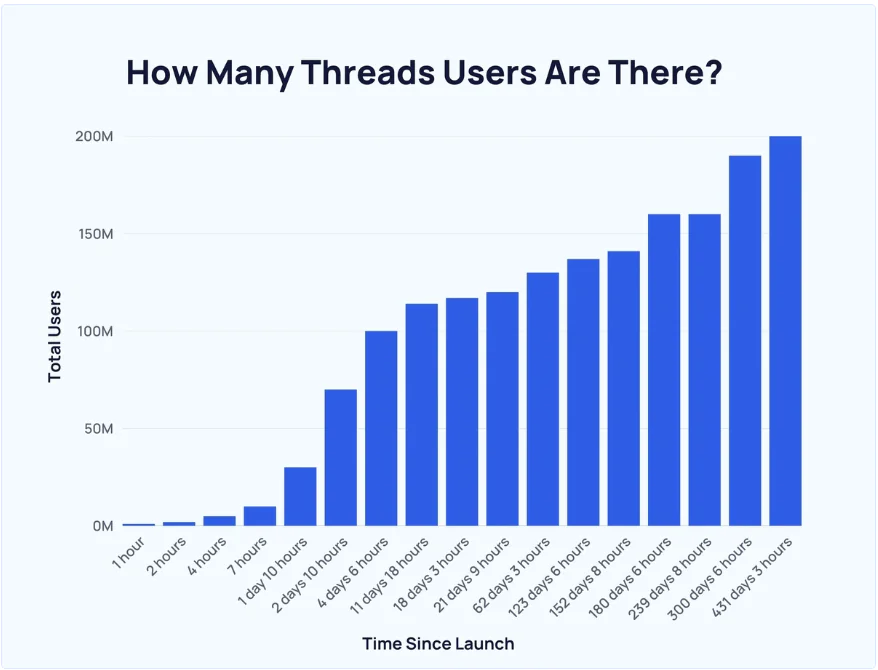
This blog explains how the Threads algorithm works, which signals affect content ranking, how the system selects feed content, and methods to increase your posts’ reach.
Core Components of the Meta Threads Algorithm
Meta describes the Threads ranking engine as an AI system rather than an algorithm, stating: “The content on your Threads feed is selected, ranked, and delivered by an AI system. Multiple machine learning models work together to create your experience“. The system selects and scores posts according to predicted user preferences.
Dual Feed Architecture
Threads offers two feeds. The For You feed uses AI to mix followed accounts with new recommendations. The Following feed shows only posts from accounts you follow, in time order.
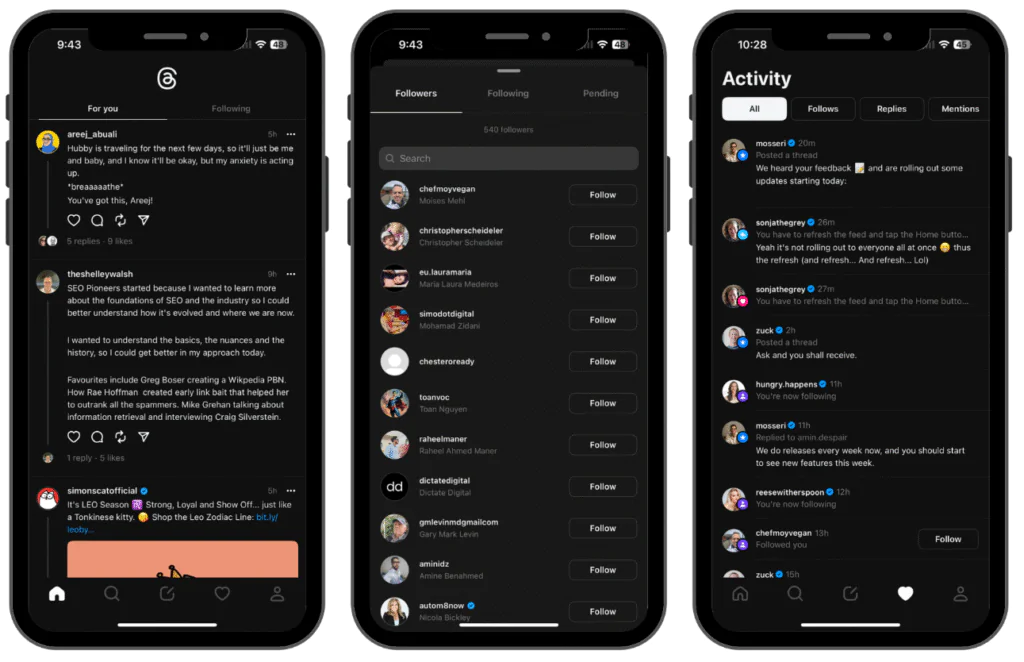
Inventory (Content Pool)
The system collects eligible public posts and content from followed accounts. Posts must comply with safety and community standards, matching Instagram’s requirements.
AI Scoring Signals
The system analyzes hundreds of signals about content and user behavior, including:
- Engagement Metrics: Tracks likes, replies, reposts, shares, and profile clicks, especially from similar users.
User-Content Interactions
Your past engagement with posts and authors shapes what you see. If you like fitness posts often, you’ll likely see more fitness content in your feed.
Relationship Signals
Your Instagram connections matter. Following someone or viewing their Instagram profile can boost their Threads content in your feed.
Content Attributes
Posts get scored based on their type (images, videos, voice notes, polls, GIFs), topics, tags, and timing. Recent posts and trending topics often get extra visibility.
Predicted User Responses
The AI makes specific predictions about your likely actions:
- Would you like the post? Based on your similar likes and author interactions
- Will you reply? Based on your reply habits and post engagement
- Will you follow the author? Based on your following patterns
- Will you check their profile? Based on the author’s popularity and your behavior
- Will you scroll past? Based on your past scrolling patterns
Final Ranking
The system combines all signals to assign each post a value score. Posts predicted to interest, inform, or entertain you appear higher in your feed. As Meta puts it, “Content that the system predicts will provide more value for you is shown higher in your feed.”
How the Meta Threads Algorithm Works
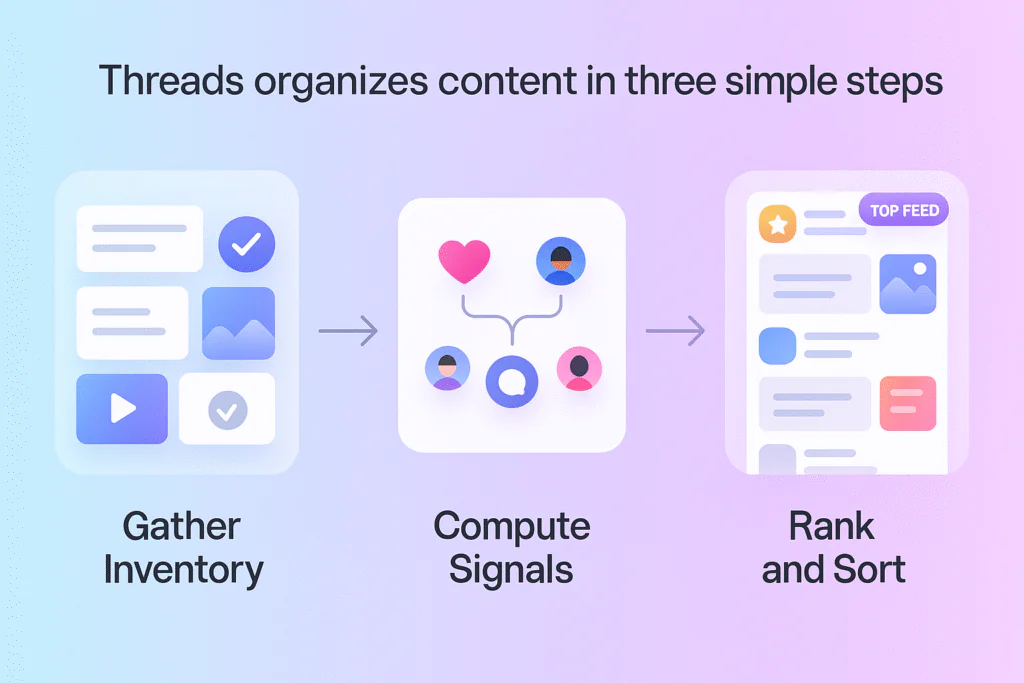
Threads organizes content through a three-step process occurring instantaneously:
Gather Inventory
The platform first builds a collection of potential posts from public Threads’ content and posts from accounts you follow. It maintains strict quality standards and only posts that follow Instagram/Threads guidelines (keeping out harmful content, offensive material, etc.).
Compute Signals
The system then analyzes various factors for each post. It considers how you respond to similar content and how others engage with that post, as mentioned earlier. Important factors include your interaction patterns (what you like, reply to, or share), who created the post (are they someone you know?), Details about the content (pictures, video duration, subject matter), how recent it is, and more. The Threads team emphasizes that “actions requiring more effort carry more weight”. For instance, taking time to write a comment or check out someone’s profile shows you’re interested.
Rank and Sort
The system combines these factors to evaluate each post. Posts predicted to engage you appear at the top of your feed, while less relevant content moves down. The algorithm functions as a content curator, prioritizing posts matching your interests.
How Threads Ranks Your Content
There are three main principles for content ranking:
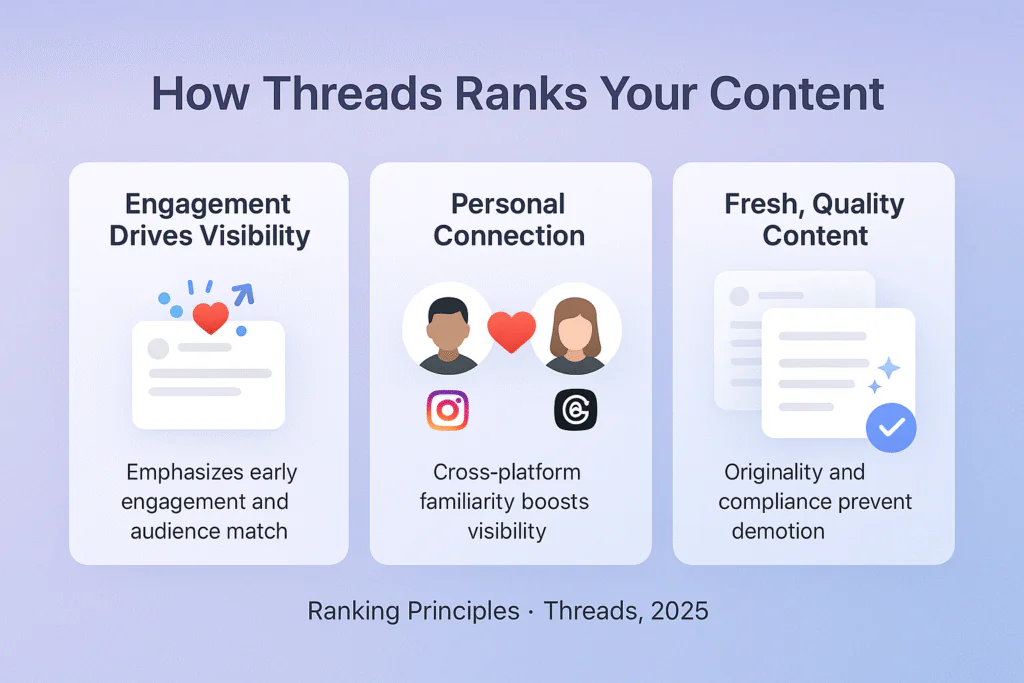
Engagement Drives Visibility
Posts rapidly accumulating likes, replies, and shares receive top placement. Early interactions, particularly from users matching the intended audience, significantly boost post visibility.
Personal Connection
Content from topics, hashtags, or accounts you previously engaged with receives priority. When you regularly interact with creators on Instagram or follow their activity, their Threads posts gain prominence in your feed.
Fresh, Quality Content
Original, well-crafted posts adhering to community guidelines receive higher visibility. Breaking news or novel perspectives on topics gain additional exposure. The system demotes repetitive, spam-like content or posts violating community standards (following Instagram’s community guidelines).
How Threads decides what to show you
The Threads system considers these factors when deciding what to show you (based on Meta’s public information):
- Your Activity Pattern: How you interact with posts through likes, replies, reposts, or simply scrolling past them.
- Creator Connection: Your relationship with the post creator, including follows on both platforms, profile visits, and shared connections.
- Post Elements: Things like pictures, videos, polls, text length, topic tags, and language choice.
- Overall Response: Total engagement on the post and how similar users react to it.
- Timing: When the post was shared (with newer content often getting priority).
- Content Standards: System checks for guideline violations (lower-quality posts get less visibility).
- Behavior Prediction: Special scores that estimate how likely you are to like, reply to, or follow the post.
The system assigns different weights to each factor based on your platform usage patterns. Though Meta withholds exact calculations, they confirm that meaningful actions (thoughtful replies or time spent reading posts) outweigh passive viewing in the ranking algorithm.
New Features Affecting the Meta Threads Algorithm
Threads continuously add features, introducing new signals to the algorithm. Content creators must monitor these updates to understand their impact on content visibility:
1. Fediverse Content Feed
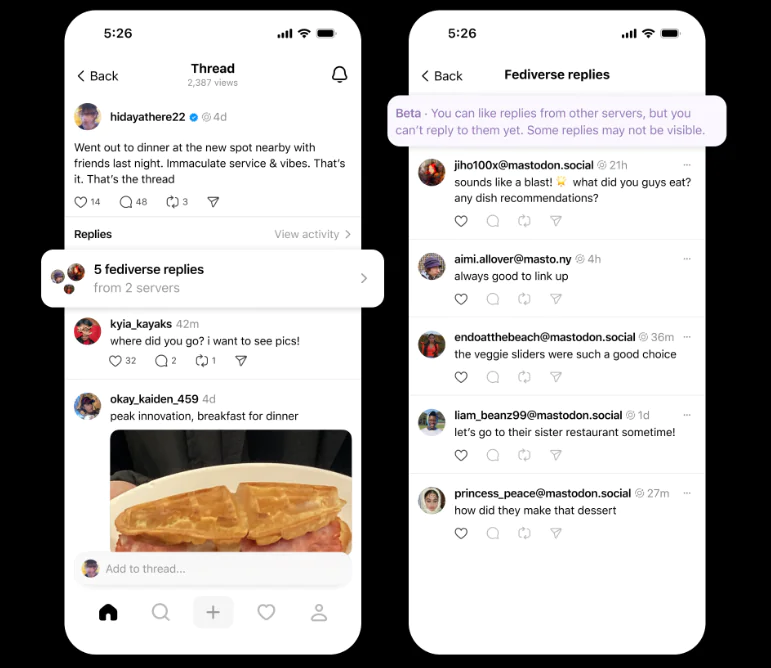
Meta launched a Fediverse feed (summer 2025) for users connecting to federated networks like Mastodon. This chronological feed operates independently from the AI-ranked main feed. Fediverse accounts and ActivityPub service posts appear in a dedicated section separate from your For You content.
For now, fediverse posts stay separate from the main algorithm by design. While Meta might blend these posts into the AI feed in the future, creators shouldn’t count on fediverse content to boost their visibility just yet.
2. Trending Topics
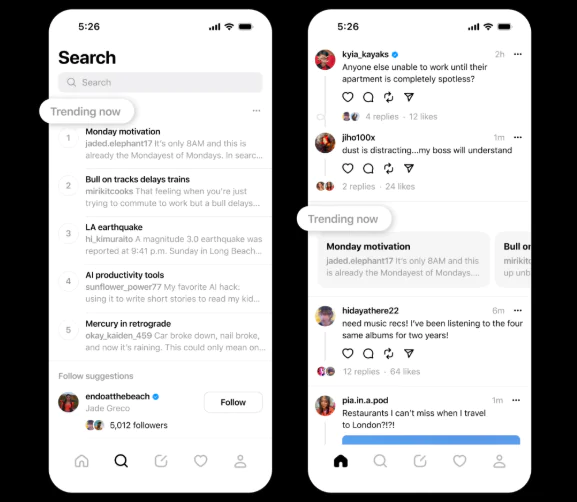
The Trending Now feature (launched March 2024) showcases popular discussion topics. The Threads algorithm identifies trends by monitoring sudden increases in posts and engagement around specific topics, which creators can leverage to expand their reach.
Posts using trending hashtags have better chances of showing up in search results and related feeds. Social media experts suggest joining trending conversations – for instance, using #WorldCup2025 when it’s trending can help your content reach more people.
3. New Content Formats
Threads evolved from a text platform to support rich media formats that influence engagement metrics. As of late 2025:
Images & Video
The platform supports photos and videos up to 5 minutes. Approximately 25% of posts contain images. Clear, high-quality visuals generate higher engagement rates.
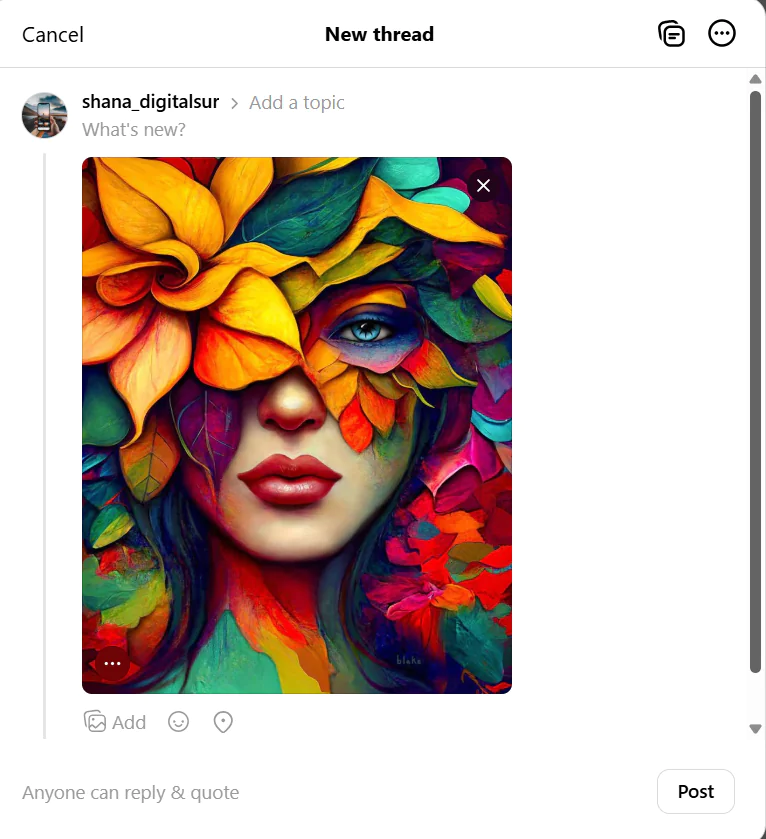
Polls
You can create polls with up to four options to connect with your audience. These interactive elements naturally encourage people to vote and comment.
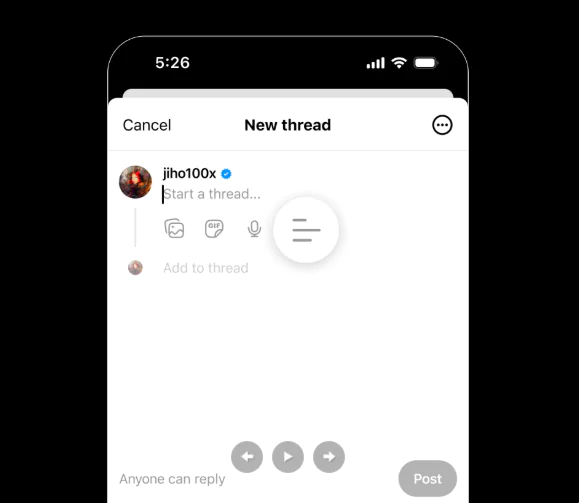
GIFs
Thanks to GIPHY integration, you can add animated GIFs to make your posts pop. These eye-catching elements often lead to more interactions.
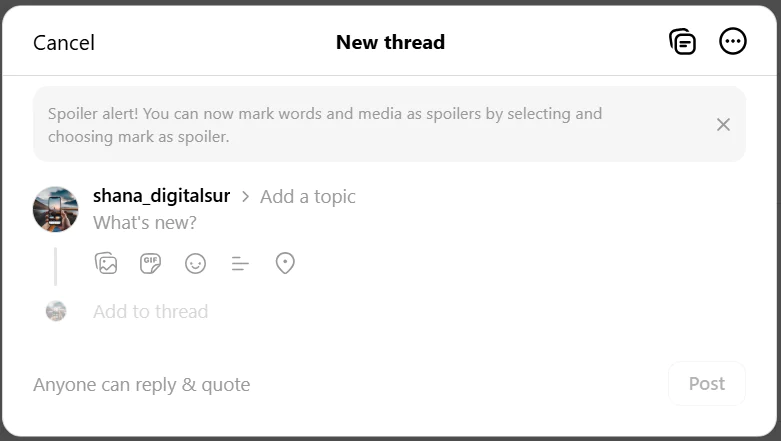
Voice Notes
Users love recording short voice messages, especially younger audiences who appreciate the personal connection. Voice notes work great for sharing stories or answering questions.
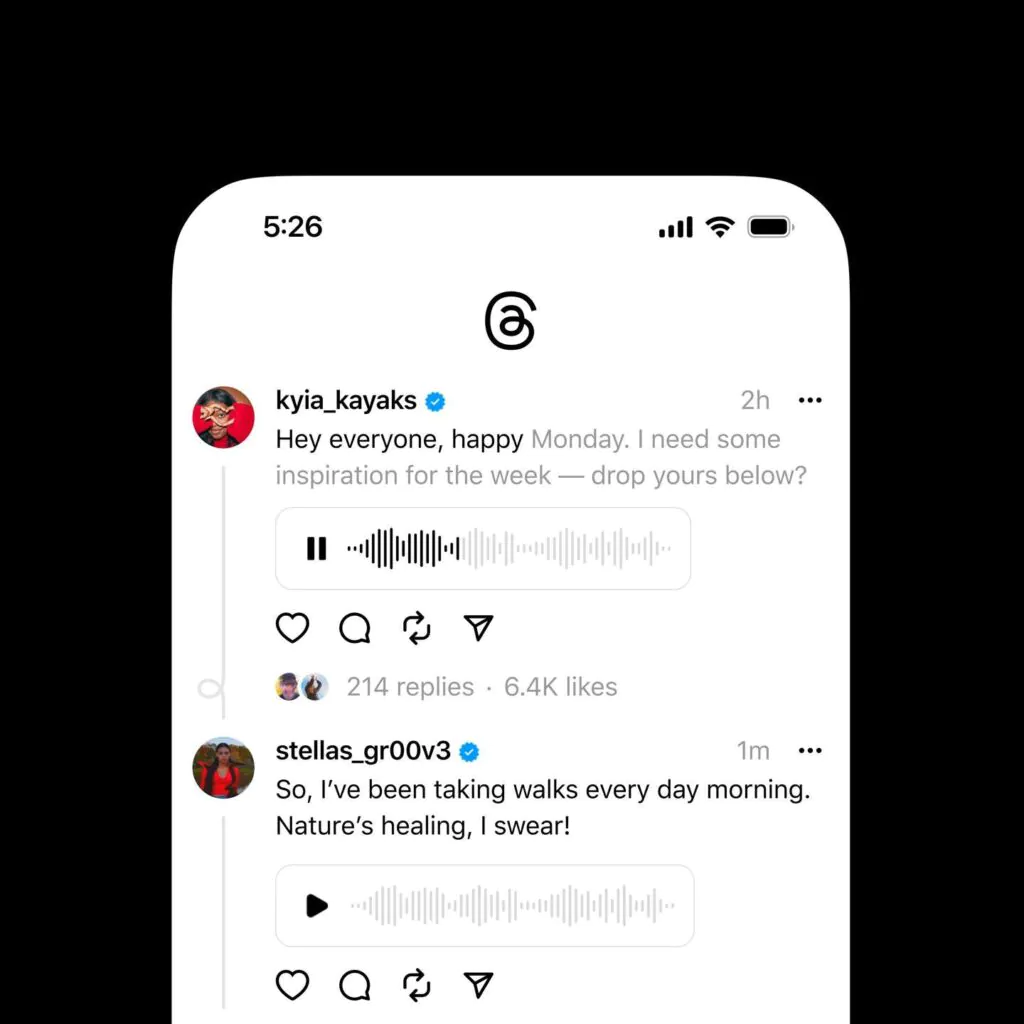
4. Topic Tags
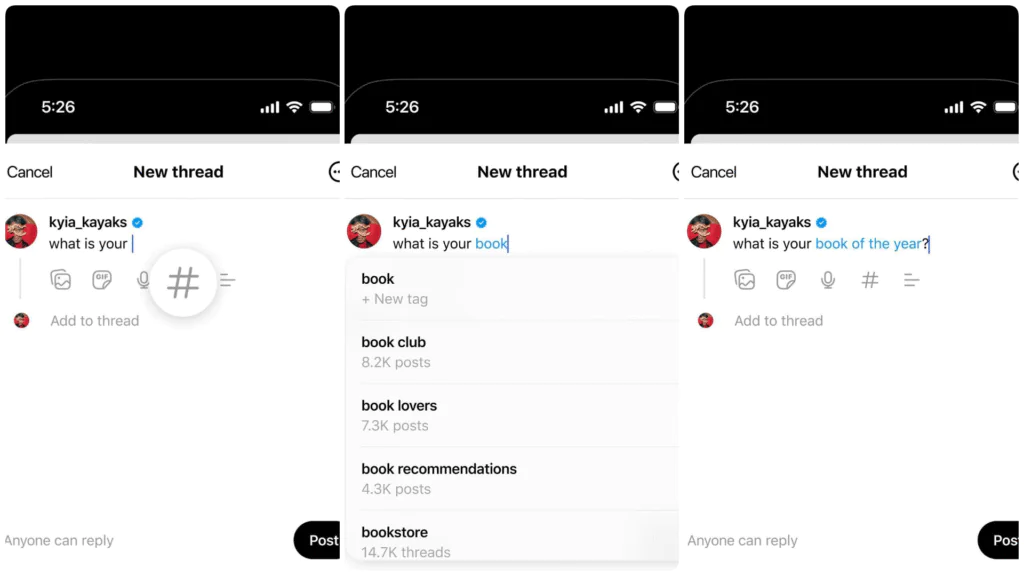
Threads employs “topic tags” rather than hashtags to categorize similar content. Users have created over 50 million topic tags since launch, forming active communities around shared interests (like #PhotographyThreads). Adding relevant topic tags connects your content with users interested in those subjects.
The algorithm factors these tags when distributing content. Posts combining text with photos or interactive polls receive more attention than plain text posts due to higher interaction rates. Meta’s research demonstrates posts containing links or media reach larger audiences, reflecting how the system rewards content diversity.
5. Developer API and Metrics
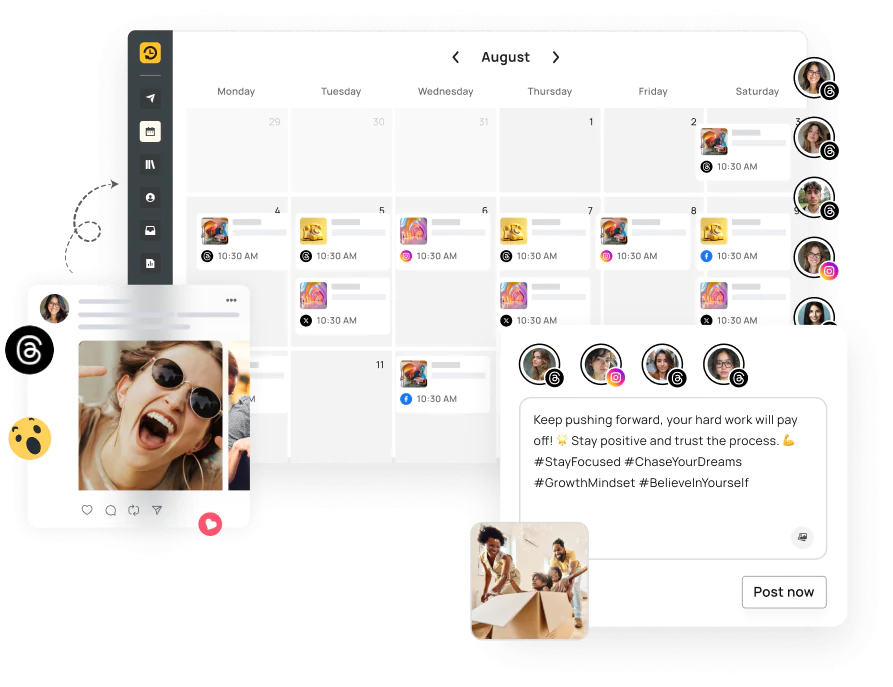
Meta released a Threads API enabling developers to publish posts, retrieve content, manage replies, and analyze post performance. Tools like RecurPost facilitate content scheduling and performance tracking. The API expands with features including topic-tagged posting and profile search.
Technical Implementation Meta Threads
Threads operates on Meta’s technology infrastructure and AI systems, sharing architecture with Instagram. The following explains how Threads processes millions of users:
AI-Powered Architecture
Meta constructed Threads with collaborative AI models that rank posts and analyze content (text and images). The platform runs on Meta’s cloud infrastructure, delivering real-time updates to hundreds of millions of users. Though specific implementations remain proprietary, the core process (content collection → signal analysis → post ranking) employs advanced AI comparable to Instagram’s Explore and Facebook’s News Feed.
Storage and Data Flow
Meta manages Threads’ core data through its existing systems. The platform stores posts and connections in TAO, Meta’s social graph database powered by MySQL. For quick feed updates and rankings, they use ZippyDB, their high-speed key-value storage system. The team confirms that ZippyDB handles feed organization and status, making it easy to quickly find each user’s personalized content and post rankings.
Scalability for Viral Growth
When Threads launched, the demand was huge. Meta prepared by boosting their system capacity by 100×. Their ZippyDB team could split data spaces without any downtime, helping the database grow smoothly. This came in handy when millions of people joined Threads within days; the system automatically spread the feed data across servers to keep everything running smoothly.
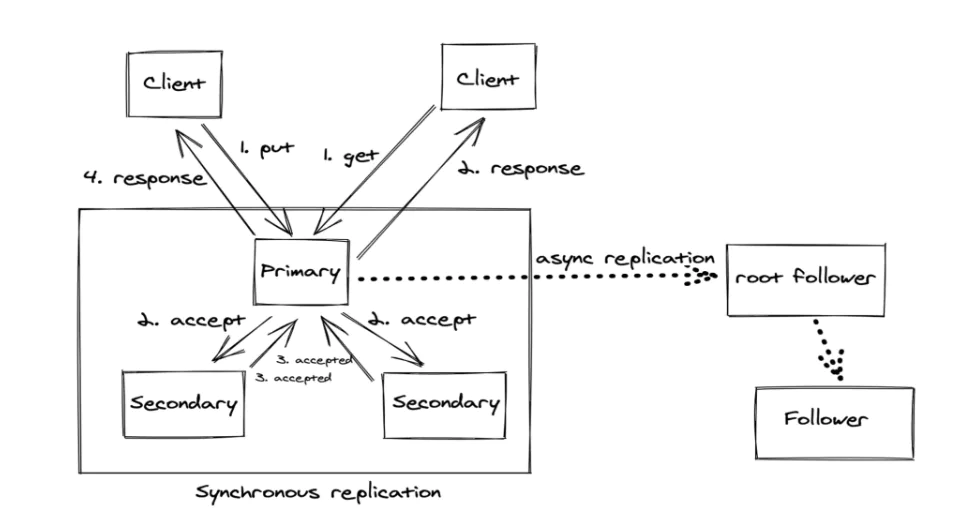
Asynchronous Processing
Meta handles big tasks through their Async system, which runs complex operations in the background. For example, when new users want to follow all their Instagram connections on Threads, they might need to copy thousands of follow connections. Instead of doing this immediately, Threads queues these tasks to run later. Meta says Async handles trillions of operations daily, managing things like mass notifications or bulk follows without slowing down your feed. This keeps the app responsive even during heavy backend work.

Global Distribution
Threads runs its feeds and services through Meta’s worldwide data centers. Since they launched in over 100 countries at once, Meta uses its content delivery networks and edge computing to serve feeds quickly everywhere. The system also handles language translation automatically, showing posts in each user’s preferred language.
Ecosystem Context
Threads’ position in social media provides context for its algorithm:
Platform Growth vs. Competitors
Threads has grown incredibly fast, reaching 320 million monthly active users by early 2025. This puts it ahead of Bluesky (196 million users) but behind X, formerly Twitter (600 million users). In early 2025, Threads added 30 million users in just one quarter, showing strong momentum.
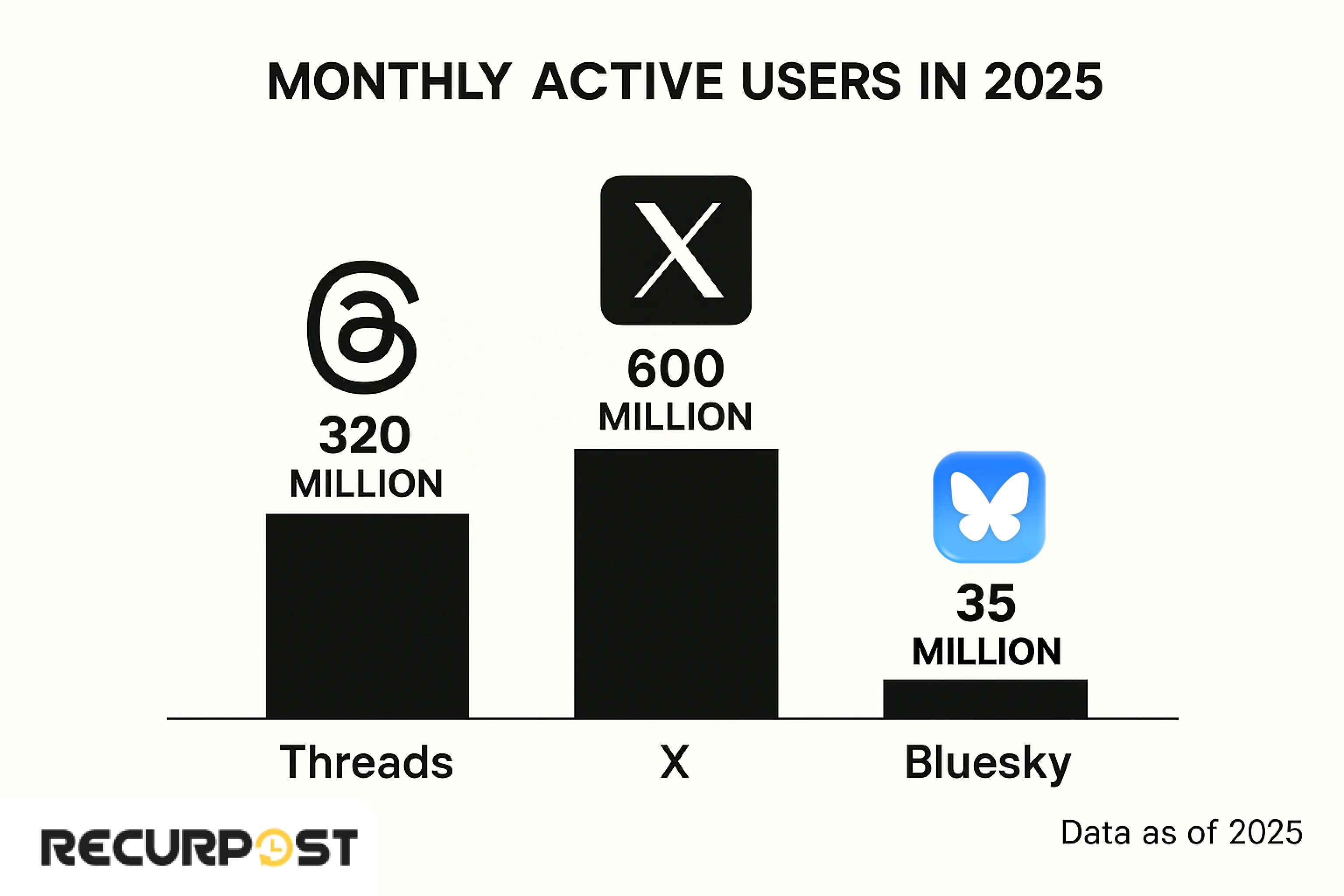
Integration with Instagram/Facebook
Threads connects deeply with Meta’s ecosystem. You need an Instagram account to join, and your username, verification, and settings transfer over. Your Instagram followers can easily find you on Threads, and posts can be shared across platforms. Success on Instagram often boosts your Threads presence, and vice versa.
Open Networking
Meta plans to make Threads an “open social” platform by integrating with ActivityPub (the fediverse protocol). This means users from other platforms like Mastodon or Tumblr will be able to interact with public Threads posts without having a Threads account. While this openness is unique among major social apps, its impact on content ranking remains to be seen. For now, content mainly stays within Threads, though it can tap into the existing decentralized network.
Monetization and Ads
Threads started showing ads in early 2025, earlier than initially planned. The platform now displays image-based ads in the For You feed, similar to Instagram’s approach. These ads compete with organic content, giving creators a new factor to consider. While currently limited to static images, more ad formats are likely coming soon.
Privacy and Data
Threads uses various user signals to power its AI, including threads’ profile data and browsing history. Users can control what they see, and these choices influence recommendations. The platform follows Meta’s privacy policies and uses the same ad targeting system as Facebook and Instagram. This means the Threads algorithm can understand audience interests from both public and private signals shared across Meta’s platforms.
Future Directions: Threads Posts
Meta’s roadmap and industry trends indicate several forthcoming changes to the Threads algorithm:
Enhanced Recommendations and Search
Meta plans to enhance its recommendation engine and search functionality. Users will receive more accurate feed suggestions and advanced search capabilities for real-time topic tracking. The AI will refine user preference analysis, requiring creators to incorporate clear keywords for improved discoverability.
Integration of Fediverse Over Time
Though federated content remains segregated currently, future updates may integrate Fediverse content into For You feeds. This integration would extend content reach to Mastodon users, broadening audience beyond Threads. Monitor how cross-platform engagement influences content visibility.
New Content and Interaction Modes
Meta will add more ways to interact, including DMs, in mid-2025. We might see Voice Threads, polls, or collaborative features. Each new addition will create fresh engagement opportunities that the algorithm will track.
Monetization Evolution
As ads come to Threads, the algorithm will balance organic and paid content. Meta will ensure ads reach engaged users while keeping the feed authentic.
AI and Personalization Advances
Meta’s AI investments suggest smarter features ahead. The Threads algorithm might evolve from just ranking content to actively connecting creators with trending conversations.
Regulatory and Community Feedback
User feedback shapes the Threads algorithm. When users ask for more control, Meta responds with features like chronological feeds and transparency tools. Creators need to stay flexible as these changes roll out.
Conclusion
The Threads algorithm operates through AI-powered “For You” feeds that learn from user interests and engagement patterns. Successful creators adapt strategies as new features emerge, from polls to federated content.
Creating engagement-driving, relevant content increases visibility on Threads. The platform prioritizes meaningful content that resonates with users, fostering an environment where creative ideas flourish.
FAQs on the Threads Algorithm
1. How does Threads support long-term content strategy planning?
Threads work best when you post consistently and stick to a well-defined content calendar such as RecurPost. This approach helps the Threads algorithm understand your niche and reward you with better visibility over time.
2. Can Threads help you discover what content resonates with your audience?
Yes! The threads algorithm analyzes what people engage with, so you’ll start seeing patterns in what performs well. Use these insights to refine your relevant content and stay ahead with your social media strategy.
3. What makes Threads different from other social media platforms when it comes to interactions?
Unlike other social media platforms, Threads prioritizes real-time discussions and contextual replies over flashy visuals. That means your conversations with other users carry more weight than just passive views or likes.
4. Is Threads useful even if you’re not a frequent poster?
While you can still engage with the platform, Threads rewards those who post consistently. Regular updates help the Threads algorithm learn your content style and place you better in its ranking factors.
5. How do Threads features influence your content visibility?
Threads features like reposts, replies, and link sharing give your posts more traction within the Meta Platforms ecosystem. Using them smartly boosts your discoverability without relying on paid reach.
6. Should Threads be integrated into your broader social media platform strategy?
Absolutely. Threads fit naturally into your overall content strategy by focusing on conversations and timing. It complements your presence on other platforms by strengthening your community engagement in real-time.

Shalini Nagar is an experienced content writer with a proven track record of creating diverse and engaging content across various formats. With years of expertise in crafting blogs, articles, she excels at delivering compelling narratives tailored to different audiences.

